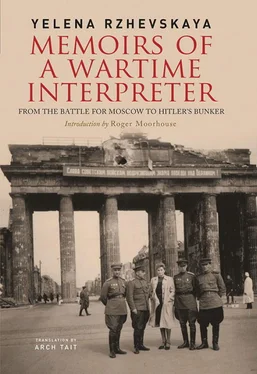We had driven on a little when suddenly the roar of guns broke the stillness that had reigned for the last few days. My heart sank instantly. What was this? Surely not war again? I did not immediately realize it was a celebratory salute! Above the hideous ruins, above the smoke and dust of battle that had yet to clear, above the grim Reichstag building and the new spring grass, tracer bullets flew skywards and the smoke-laden heavens were lit up by flashes of colour. Heavy artillery boomed, machine guns rattled, submachine guns were fired. Shrapnel clattered down on the cratered roadway. The thunder grew louder and everything around was shaking as it did in time of battle.
We returned to Buch, taking Käthe Heusermann with us. There were no lights burning in the windows of Germans: the vanquished were asleep. The victors, having celebrated all day, quietened down, but none of the wine of victory passed my lips. I just went to bed.
The Identification
Lovers of crime novels will, perhaps, be disappointed: there were no ambushes, no shots fired from round a corner, no safes were cracked. I will add, to the chagrin of those who prefer legend to the truth, that there were no cunningly disguised doubles.
I told the tale above of the origin of one would-be double. But that male corpse with his darned socks, who was so lovingly filmed for the newsreels, was no double, put in place as a decoy and to facilitate Hitler’s escape, as suggested by later, romanticized accounts. It was just the body of one of the many occupants of the bunker, killed by shrapnel or shot by Hitler as the end approached, and any resemblance to the Führer was mostly the product of the over-excitability of the time.
Other ‘doubles’ popped up, and here is why. Colonel General Berzarin, the commandant of Berlin, promised he would nominate for the award of Hero of the Soviet Union anyone who located Hitler’s corpse. As a result, half a dozen dead ‘Hitlers’ were dragged along to the Commandant’s Office, giving rise to the tale of doubles.
At this crucial stage in our mission, luck was on our side. As always, much was down to chance. Crucial circumstances jostled side-by-side with insignificant developments but, by the same token, the insignificant sometimes proved crucial.
Käthe Heusermann might have flown to Berchtesgaden, where Hitler was assembling his attendant staff with the intention of moving there himself. Dr Blaschke had, after all, urged her to fly out with him. She had refused, because for so long she had had no letters from her fiancé, the non-commissioned officer stationed in Norway, and was afraid he would be unable to find her if she left. She told me she had also buried her dresses at a resort near Berlin to keep them safe from the bombing and fires, and was reluctant to leave them. That, too, had caused her to stay.
That is how historically insignificant circumstances did history a big favour. Käthe stayed in Berlin and, as a result, did not vanish into oblivion, did not simply disappear. She was the only available person who knew and remembered all the distinctive features of Hitler’s teeth, and her contribution to identifying his remains was crucial. With Käthe Heusermann’s help we obtained irrefutable evidence that Hitler was dead and were able to pass it on to our descendants.
Käthe first described Hitler’s teeth from memory. It was now 10 o’clock in Berlin-Buch, the following morning, 10 May. She was being interviewed by Colonel Gorbushin and Major Bystrov, and I was translating and making notes. I asked her not to give the teeth their specialist names – incisor, canine and so on, for fear I might not correlate the German and Russian terms correctly. Instead she simply gave them numbers. The note I made is as follows:
Hitler’s upper denture was a gold bridge attached to the 1st left tooth with a window crown, to the root of the 2nd left tooth, to the root of the 1st right tooth and to the 3rd right tooth with a gold crown…
Käthe told us:
In autumn 1944 I took part in the extraction of Hitler’s sixth tooth on the left in the upper jaw. For that purpose I and Dr Blaschke travelled to his staff headquarters in the vicinity of Rastenburg [in East Prussia]. In order to remove the tooth, Dr Blaschke used a drill to saw through the gold bridge between the 4th and 5th teeth in the upper jaw to the left. At this time I was holding a mirror in Hitler’s mouth and attentively observing the whole procedure.
We could compare this with the report of the medical examination of 8 May, which read, ‘Bridge of upper denture on left behind premolar tooth (4) sawn vertically’. The report devotes a lot of space to a meticulous description of the other teeth. We had also X–rays that we found in Dr Blaschke’s little room under the Reich Chancellery.
Most importantly, we could compare her description with the contents of the jewellery box. Käthe Heusermann examined these and confirmed that they were indeed Hitler’s teeth.
She recalled this many years later for Die Welt. The article, like other materials from abroad, came into my hands quite by chance. Leon Nebenzahl, who translated my Notes of a Military Translator, showed me the magazine clipping on a visit to Moscow.
‘This took place in a house near Berlin,’ she writes, ‘in the presence of a colonel, a major and an interpreter. “Look closely,” the colonel instructed me, “and tell us what this is, if you know.”’
She describes examining the teeth taken out of the box and recognizing them. ‘I took the dental bridge in my hand. I looked for an unmistakeable sign. I found it immediately, took a deep breath and blurted out, “These are the teeth of Adolf Hitler.” I was showered with expressions of gratitude.’
Subsequently Heusermann talked to the specialists. Their report notes that, in conversation with the principal forensic expert of the front, Medical Service Lieutenant Colonel Shkaravsky, ‘which took place on 11 May 45’, Citizen Heusermann, Käthe ‘described in detail the condition of Hitler’s teeth. Her description coincides with the anatomical features of the oral cavity of the charred unknown male on which we conducted an autopsy.’ She also drew a diagram of Hitler’s teeth from memory, pointing out all their specific features.
After reading the first edition of my book, Faust Shkaravsky thanked me for mentioning him and corresponded with me for many years until his death. He sent me a photographic reproduction of that diagram, which he had kept, accompanying it with an explanation:
Heusermann and I had a disagreement concerning false teeth on steel posts. During the initial examination of the teeth I registered the presence of two posts, in the 2nd left and 2nd right upper incisors. Heusermann claimed there was a third.
At the end of our preliminary conversation, Käthe Heusermann was shown Hitler’s teeth and we conducted a joint inspection of them. Käthe Heusermann was right: a third post was found in the right lower canine. This disagreement, in which Heusermann proved correct, was further proof of how precisely she knew everything about Hitler’s teeth.
‘All this can be confirmed by Blaschke’s dental technician, Echtmann,’ Käthe told us at the first interrogation. Bystrov and I went to Echtmann’s apartment. In my diary I have a description of Echtmann’s worn-out, listless wife (who I thought must be suffering from a thyroid disorder). She clung desperately to her husband, who was also frail and sickly.
Fritz Echtmann, dental technician, was a short, dark-haired man with a pale complexion, aged thirty-something. He had worked at Dr Blaschke’s private laboratory on Kurfürstendamm since 1938, and made false teeth for Hitler. He, too, first gave a description of them from memory, and then had an opportunity to inspect them in Buch, where he, too, identified them.
Читать дальше











